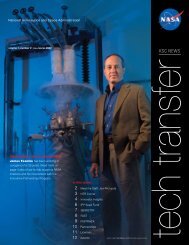2006-2007 - Kennedy Space Center Technology Transfer Office
2006-2007 - Kennedy Space Center Technology Transfer Office
2006-2007 - Kennedy Space Center Technology Transfer Office
- No tags were found...
Create successful ePaper yourself
Turn your PDF publications into a flip-book with our unique Google optimized e-Paper software.
Launch Pad 39 Hail Monitor Array SystemLocalized-WeatherForecasting andMeasurementWeather conditions at <strong>Kennedy</strong> <strong>Space</strong> <strong>Center</strong> are extremely dynamic, and they greatlyaffect the safety of the <strong>Space</strong> Shuttles sitting on the launch pads. For example, onMay 13, 1999, the foam on the External Tank (ET) of STS-96 was significantlydamaged by hail at the launch pad, requiring rollback to the Vehicle Assembly Building.The loss of ET foam on STS-114 in 2005 intensified interest in monitoring and measuring damage to ET foam,especially from hail. But hail can be difficult to detect and monitor because it is often localized and obscured byheavy rain. Furthermore, the hot Florida climate usually melts the hail even before the rainfall subsides.In response, the hail monitor array (HMA) system, a joint effort of the Applied Physics Laboratory operated byNASA and ASRC Aerospace at KSC, was deployed for operational testing in the fall of <strong>2006</strong>. Volunteers fromthe Community Collaborative Rain, Hail, and Snow (CoCoRaHS) network, in conjunction with ColoradoState University, continue to test duplicate hail monitor systems deployed in the high plains of Colorado.Shuttle Launch Pads 39A and 39B.Location of hail monitor stations, HM-1, HM-2, andHM-3, at Launch Pad 39A.The HMA system consists of three stations approximately500 ft from the launch pad. The hail monitor sensor isbasically a metal plate in the shape of a shallow pyramid.It deflects hail from the sensor surface after one hit, thuspreventing multiple bounces from the same hail stone. Amicrophone pickup is mounted beneath the center of themetal plate. The output of this microphone is connectedto an electronic circuit that digitizes and processes themicrophone signal and then transmits a trigger pulse to oneof six output channels. Each output channel represents asignal that is twice as large as the previous channel, therebycategorizing the hail stone into one of six sizes, fromdiameters of about 10 to 20 mm, in 2-mm steps. The sixoutput channels are connected to six liquid-crystal diode(LCD) counters, which create a permanent record of all hailhitting the sensor. The counters are manually reset after ahail storm.The HMA system was first deployed to Launch Pad 39Bfor support of STS-115 in September <strong>2006</strong> and then toPad 39A for support of STS-116 in December <strong>2006</strong>. Thesystem’s deployment in support of STS-117 collected andanalyzed data of foam damage from a freak hail storm onFebruary 26, <strong>2007</strong>, that delayed the launch of Atlantisfor nearly two months (also see “Hail Size DistributionMapping,” page 52.Support of STS-118 showed another important use of thehail monitor system. On July 13, <strong>2007</strong>, hail was observedon the ground at the Vehicle Assembly Building, butno hail was recorded at the pad occupied by Endeavour.United <strong>Space</strong> Alliance Ground Operations personnel checkthe hail monitors every morning when a vehicle is on thepad and after any storm suspected of containing hail. Ifno hail is recorded by the hail monitors, the vehicle andpad inspection team has no need to conduct a thorough54 Range Technologies













